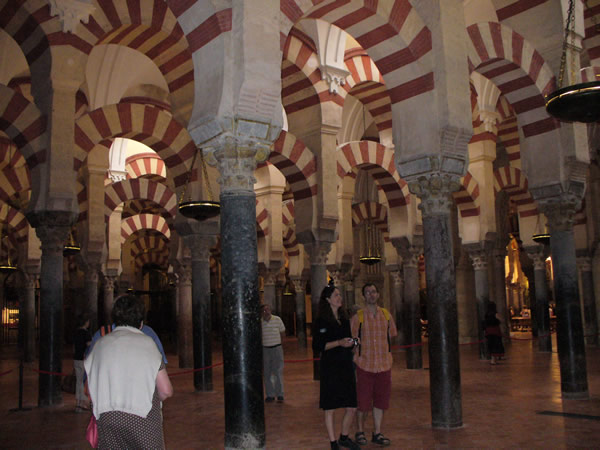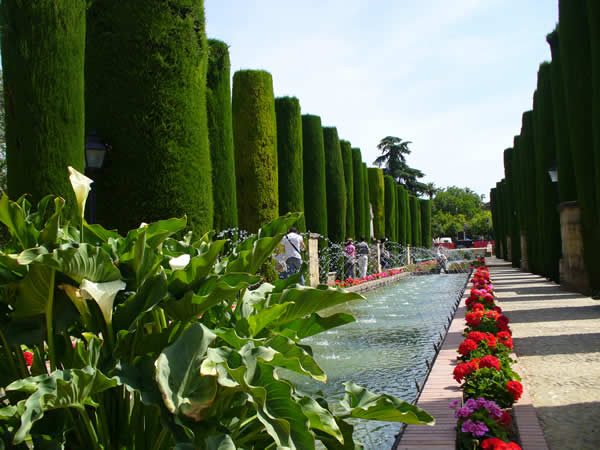This post is also available in:
![]() Deutsch
Deutsch ![]() Italiano
Italiano ![]() Português
Português ![]() Español
Español
Cordoba – 320,000 inhabitants – is one of the most interesting cities of Andalusia in southern Spain. The city was originally founded by the ancient Romans who called it Corduba. Being located in the inland navigable point of the Guadalquivir river, the city in Roman times became a port and a commercial center of great importance. The majestic Roman bridge remains from this period.
In 711 it was conquered by the Arabs. During the Arab domination (711-1263), Cordoba was the cultural and artistic center, as well as the main center of power of the Iberian peninsula. At that time it was one of the largest cities in Europe, it is estimated that it had a population of around 500,000 inhabitants.
When the Ummayadi caliphs were deposed in Damascus, in 756 they moved to Cordoba where they ruled an independent emirate until 929. The city reached the peak of its power in the tenth century, under the governments of Abd al-Rahman III (who proclaimed himself Caliph in 929), under his son al-Hakam II (961–76) and under Al-Mansur Ibn Abi Aamir (Almansor or Almanzor, 981–1002).
Cordoba during this period was the capital of a Caliphate (also known by the name of Al-Andalus) which controlled almost the entire Iberian peninsula. It was during this period that the main Islamic buildings of Cordoba were built. Among these, the most important is certainly the Mezquita, whose construction began in 784. The building was built on the site of a Christian basilica. In the 10th century the mosque was enlarged to become one of the largest mosques in the world.
At the beginning of the 11th century, several decades of civil war led to the collapse of the Caliphate and its consequent dismemberment into many small Muslim kingdoms, called “reinos de taifas”. Christian forces occupied Cordoba in 1236.
WHAT TO SEE: CORDOBA’S MAIN ATTRACTIONS
Since 1994 the historic center of Cordoba has become part of the UNESCO World Heritage List. The visit of the city must obviously start from the wonderful mosque (Mezquita), which is the most famous and most beautiful building in the city.
THE CHURCH – MOSQUE: THE MEZQUITA
Entrance is via the Patio de los Naranjos, a classic Islamic ablution courtyard embellished with orange trees and fountains. Originally all 19 aisles of the mosque were open to this courtyard, producing a striking scenic effect.
After the Christian conquest, chapels were built inside the mosque: in 1371, Alfonso X built the Capilla Villaviciosa with surprising arches. In the 14th century Henry II built the Capilla Real in the Mudejar style which was used as a pantheon for the Spanish rulers.

In 1523 the construction of the Cathedral began inside the mosque, which was completed in 1599, which led to the construction of this extraordinary architectural union of church-mosque that we can admire today.
Other important monuments of the city are the defensive structures of the Alcázar de los Reyes Cristianos (1328) and the Torre Fortaleza de la Calahorra which controls the ancient Roman bridge. Next to the bridge are large Arab mills, the ancient Jewish Synagogue, the Caliph Baths, the typical streets and squares of the medieval Jewish quarter called Judería. In the plaza de la Corredera are the remains of a Roman temple, the Renaissance Ayuntamiento and nearby the Romanesque church of San Pablo.
Just 7 kilometers from the city of Cordoba along the N-437 road there is another splendid testimony of Arab domination. The ruined city of Medina Az-Zahra, a pleasure city built in the 10th century by Abd al-Rahman III and completed by Almansur.
The climate of Cordoba.
This post is also available in:
![]() Deutsch
Deutsch ![]() Italiano
Italiano ![]() Português
Português ![]() Español
Español
